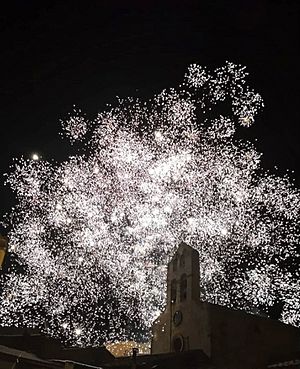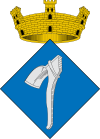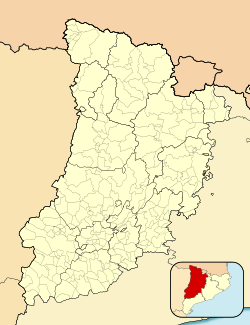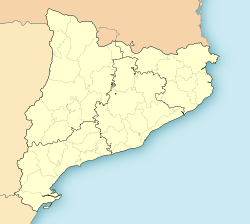Vinaixa facts for kids
Quick facts for kids
Vinaixa
|
||
|---|---|---|
|
Municipality
|
||

Fireworks outside the church of St. John the Baptist
|
||
|
||
| Country | ||
| Community | ||
| Province | Lleida | |
| Comarca | Les Garrigues | |
| Area | ||
| • Total | 37.6 km2 (14.5 sq mi) | |
| Elevation | 479 m (1,572 ft) | |
| Population
(2018)
|
||
| • Total | 482 | |
| • Density | 12.819/km2 (33.20/sq mi) | |
| Demonym(s) | Vinaixenc | |
| Postal code |
25440
|
|
Vinaixa is a small town in the Les Garrigues region of Catalonia, Spain. It is located in the province of Lleida. The town center is built around an old castle. Many buildings here are made of stone.
Vinaixa is known for its stone industry, which has been important for many years. The area also has many pine forests. A big attraction is the St. John the Baptist church. It is built in a mix of Romanesque and Cistercian styles. Inside, you can see old Romanesque paintings and a beautiful Gothic altarpiece.
Contents
Where is Vinaixa?
Vinaixa is in the southeastern part of the Les Garrigues region. It sits on high ground, near the border with Conca de Barberà. This location was historically important for travel between the coast and inland areas.
The town covers an area of 37.60 square kilometers. It borders several other towns like Vimbodí i Poblet and El Vilosell. The main part of Vinaixa is about 480.90 meters above sea level.
Getting to Vinaixa
You can reach Vinaixa by the N-240 road or the AP-2 motorway. It is about 40 kilometers from Lleida. Barcelona is 132 kilometers away, and Madrid is 500 kilometers away.
The town has good connections to nearby villages using local roads. There is also a train station with routes to Lleida and Barcelona. A bus stop connects Vinaixa to Lleida and Tarragona.
Vinaixa's Landscape and Climate
The land in Vinaixa was formed during the Oligocene period. Several mountain ranges run through the area from north to south. These ranges create lower areas, or depressions, in the landscape. The highest points are Punta del Puig (570 meters) in the north and Punta dels Ràfols (675 meters) in the east.
The climate here is a continental Mediterranean climate. This type of climate is common in the Ebro Depression area.
A Look at Vinaixa's Past
The town of Vinaixa started in the 8th century. It grew around an Arab castle. In the 12th century, the village was called Avinasha. This name comes from Arabic, meaning 'son of Aixa'.
The Castle of Vinaixa, also known as Cal Tarragó, is at the highest point of the village (482 meters). It was an old Arab fortress. The village of Beni-Aixa, which Vinaixa is named after, grew around it. This name refers to the family who owned the land during the Arab era. Today, the castle is privately owned.
Christian Rule
When Christians took over the area, Ramon Berenguer IV helped people settle in Vinaixa. He gave them special rights in the 12th century. Later, in the 13th century, the Poblet Abbey gained full control over the area.
The Hermitage of Sant Bonifaci
The hermitage of Sant Bonifaci is a small church located 6.5 kilometers from the town center. It is dedicated to Saint Boniface, a saint that Vinaixa honors. It seems the hermitage was built in the 14th century. However, it did not get a relic (a special item) of the saint until May 1682.
What to See in Vinaixa
Vinaixa has several interesting historical places to visit:
- Casa de Poblet (or Cal Panxa): This house was built by Abbot Copons (1316-1348). It was where tithes (a type of tax) were collected. It used to belong to the monks of the Poblet Abbey. Now, it is owned by the town.
- Cal Blanco: This house was built during the Second Spanish Republic. It has a modern style.
- Casa Tarragó: This was the home of an important family in Vinaixa. Only the staircase and the front of the grand palace remain. It used to have an oil mill at the bottom of the building.
- Hermitage of Saint Boniface: This small church has a Gothic structure. It was later changed and updated. It is believed to have been built in the 14th century. You can find it 6.5 kilometers outside the main town.
- Saint John the Baptist Church: This church was built between 1301 and 1318. It shows a mix of Romanesque and Gothic styles, with strong influences from the Cistercian order. It has one main area and smaller chapels on the sides. The most special part is the entrance, which has three decorated arches. The stone carvings show plants and diamond shapes. The bell tower has four bells. The church still has some Romanesque paintings. These paintings have made it a Historic-Artistic Monument. The Gothic style altarpiece inside is also very impressive.
- Portal del Forn: This was one of four gates that used to close off the town. During medieval times, the town's oven was located here.
See also
 In Spanish: Vinaixa para niños
In Spanish: Vinaixa para niños







